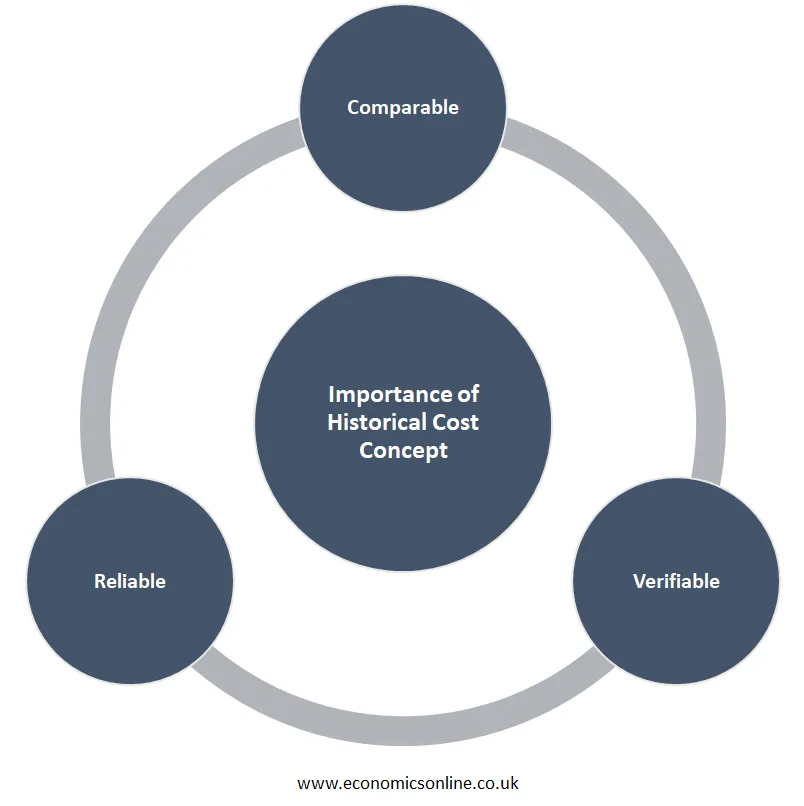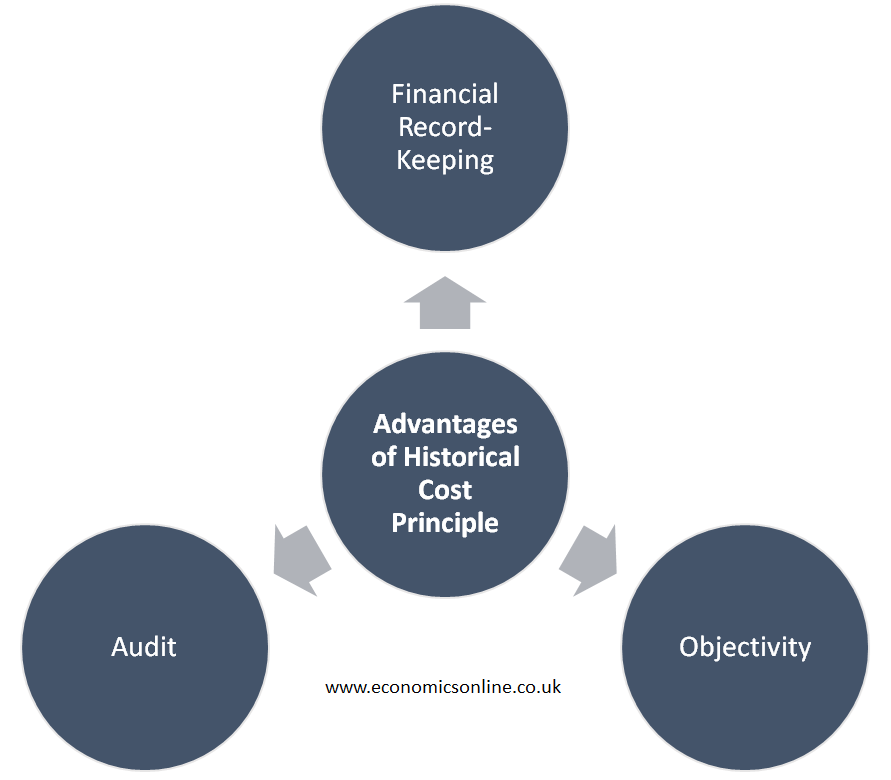
Photo by Kenny Eliason / Unsplash
Historical Cost Principle
Historical Cost
An asset’s purchase price, or its original monetary value at which it is purchased, is called its historical cost in accounting. The historical cost principle is used to record the transactions related to the purchase of assets in the books of accounts at their original acquisition cost. The historic cost of an asset may be different than the market value of the asset. For example, if machinery is purchased by paying $20000, then the business should record this machinery in the books of account at the historic cost of $20000, irrespective of what its market value is. The historical cost method is used for recording the acquisition of assets in the U.S. under GAAP (Generally Accepted Accounting Principles).
The Historical Cost Principle
According to the historical cost principle, a business firm must account for and record all assets at their original prices or purchase prices on their balance sheets. In simple words, the assets are always recorded in the books of accounts at their historic cost and not at their market value. No adjustments are allowed to reflect market fluctuations or changes made due to inflationary pressures. This concept is the basis of the ongoing trade-off between the usefulness and reliability of an asset.
The historical price or original cost of an asset is simple and reliable, whether adjustments are made or not, but it is not useful in the long run. If a building was purchased at the historic cost of $4,000,000 ten years ago, then this value does not provide the fair market value of the building at the current time.
Conservatism Principle
According to this accounting principle, expected loss can be recorded in the books of accounts but not the expected revenue or benefit. If there is an expectation or prediction of earning revenue, revenue should not be recorded until it is earned. But if a loss is expected in near future, then the expected loss can be recorded as an expense in the books of accounts according to conservatism or conservative accounting principle. For example, if there is an expectation that some debtors will not pay their due amount to the business, then provision for doubtful debts can be recorded as an expense. The historic cost principle is in line with conservatism because assets are not overvalued when recorded at their historic costs.
Generally Accepted Accounting Principles (GAAP)
Generally Accepted Accounting Principles (GAAP) are a set of accounting and financial reporting standards used by companies in the United States when they prepare their financial statements. These rules are also called the U.S. GAAP and are issued and revised by the Financial Accounting Standard Board (FASB) and the Government Accounting Standard Board (GASB). According to the U.S. Securities and Exchange Commission (SEC), all companies in the United States must use GAAP in their financial reporting to maintain their stock exchange listing. The historic cost principle is part of GAAP, along with some other principles such as prudence (conservatism), revenue realisation principle, and matching principle. The objective of GAAP is to make sure that the financial statements of U.S. companies are complete, consistent and comparable.
International Financial Reporting Standards (IFRS)
International Financial Reporting Standards (IFRS) are a set of accounting and reporting standards used by companies in more than 160 jurisdictions when preparing their financial statements. These rules are issued and revised by the International Accounting Standards Board (IASB), which is a London-based organisation. The historic cost principle is part of IFRS rules under IAS 16, which states that property, plant, and equipment should be recognised and recorded at their historic costs. IFRS is an alternative to GAAP and is widely used by many countries around the world.
Revaluation Method
Revaluation method states that the assets should be recorded at their fair market value. It is an alternative to historic cost principle. Revaluation method also falls under IAS 16 – Property, Plant and Equipment of IFRS. Revaluation method is useful for companies that have assets that have appreciated over time. This method allows for changes in the value of an asset to be reflected in the financial statements.
Net Book Value of an Asset
The net book value (NBV) of an asset is its value shown in the balance sheet. NBV is equal to the historic cost of an asset minus accumulated depreciation or amortisation. Depreciation is charged for a tangible non-current asset with limited life, whereas amortisation is charged for an intangible asset.
The book value and the fair market value of an asset are different. The fair market value of an asset is the amount or value a company expects to get on the disposal of the asset. For example, a company vehicle encountered an accident and is now out of order. The book value of this vehicle is still showing some worth of this asset, but its market price is way lower than its book value because it is completely out of order and needs a lot of repair work, which clearly involves costs.
Importance of the Historical Cost Concept
The historical cost concept is considered important because the records that are made in consideration of the historical cost principle are more reliable, verifiable, and comparable.

Reliable
The process of recording an asset or liability on the balance sheet will always remain the same. It will not change, and the financial statement users or stakeholders will always get accurate and authentic financial data from a firm for decision-making every time.
Comparable
It is easy to compare the historic cost of an asset with other assets when doing a comparative analysis if the assets are recorded regularly by using the same method on the balance sheet. This also helps make ratio analysis more meaningful.
Verifiable
All the costs incurred on an asset are 100 percent verifiable, as there is a record of all actual transactions in the form of documentary evidence when the assets were acquired.
Exceptions to the Historical Cost Principle
The following are some exceptions that are important to explain:
Highly Liquid Assets
When businesses make their balance sheets, most of the assets are recorded at their historical costs. But there are also some highly liquid assets, such as marketable securities, that need to be recorded at their fair market value. These assets are short-term in nature, and recording their fair market value helps predict the future cash flows of the company and helps financial statement users make accurate operational decisions.
Account Receivables
The debt or equity investments are also recorded at their fair market value because they are expected to be converted into cash in the short term. However, account receivables must be recorded at their net realisable value on the balance sheet. The amount of money a company predicts to receive on the payment of these account receivables is called the net realisable value.
Inventory
Inventory means the items held by a business firm for resale or business use. Inventory or stock is recorded at the lower of cost or market value.
Advantages of the Historical Cost Principle
The following are some advantages of the historical cost principle:

Financial Record-Keeping
As the cost principle represents the initial cost of an asset, it becomes easier to record the initial cost of an asset on the balance sheet because the historical cost only needs the initial cost of an asset, and due to this simplicity, firms do not need to update their financial records in order to depict the current market value of assets.
Objectivity
The historical cost principle is objective and verifiable in terms of recorded values, like bank transactions, invoices, and receipts, which are used to verify the original value of an asset at the time of purchase.
Audit
When a company hires an accountant as an auditor, it may incur additional expenses in terms of services. The accountant only needs to verify the initial value of a company’s assets, which is a quicker and easier way to verify the statements than checking the complete history of the company’s accounts.
Disadvantages of the Historical Cost Principle
The following are some disadvantages of the historical cost principle:
Market Value
The historic cost principle accounts for the original purchase price of an asset at the time when the company acquires it. It does not account for any increase in the market value of that asset due to appreciation.
Intangible Assets
It also does not account for intangible or valuable assets that a company has. For example, a company may have some valuable assets, such as intellectual property, brand identity, trademarks, patents, and goodwill from mergers. As these assets are added to a business with the passage of time, the historical cost principle is not able to include these values in the initial cost principle.
Conclusion
In conclusion, the historical cost is used to measure the asset's value for financial purposes, but not all assets can be measured by their historical costs. Impaired assets, intangible assets, and marketable securities are recorded at their current market prices on the balance sheet. The concept of historical cost is used to prevent overstating an asset’s value when the appreciation of that asset was the result of market volatility. The historical cost principle is the basic accounting principle widely used in the U.S. under GAAP.


